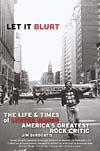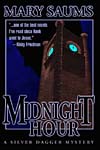
Two titles take on music industry excess
Let It Blurt
Jim DeRogatis

A million years ago when I was a teenager, I began my lifelong romance with rock magazines. I started off with sophomoric, fan-oriented metal mags like Circus, because they were the most likely to have pinups of KISS and Aerosmith. I grew out of Circus fast because it was too trite for my sophisticated, 13-year-old tastes.
But Creem magazine—now that was badass! A "gateway" publication that led me down the primrose path to a world alien to my suburban existence, Creem covered all kinds of wild stuff and celebrated deviance, excess, and lowbrow culture. Before Creem, I'd never realized that rock stars were to be laughed at and idolized at the same time. As stupid as this may sound, reading Creem forever changed my life.
Lester Bangs was top dog on the staff when I started reading Creem. Bangs was a renegade writer, producing crazy, stream of consciousness tirades that usually revealed more about the author than the subjects. He had guts, and he was unafraid to expose the ugly truth about himself in all its contradictory, drunken glory. Though he was much more gifted as a writer, Lester always really wanted to be a rock 'n' roll star; his writing took on its attitude, jargon, and rhythm.
Being a longtime fan of Bangs, I had some trepidation about the release of his biography, Let It Blurt (Broadway Books, $15.95), by Jim DeRogatis. There's an uneasy correlation between the release of Let It Blurt and Jim Carrey's recent portrayal of Andy Kaufman in Man on the Moon. First of all, both Bangs and Kaufman were mentioned in an R.E.M. song. Secondly, and more importantly, it has been so long since both Bangs and Kaufman died that the book and the movie are both likely to be perceived as the real story. And, in both cases, the public would get a better idea of who the men really were by viewing their actual work instead of the idealized versions created by other people 20 years later.
Let It Blurt reads like the usual rock bio: a tormented, drug-abusing celebrity (or semi-celebrity in Bangs' case) leads a debauched life that gets successively worse as addiction replaces expression as a primary motivation. The book starts out interestingly enough and goes on a downward spiral. DeRogatis' blow-by-blow account of Bangs' addiction desensitized me to a point where I was almost glad Bangs O.D.'ed at the end so I could stop reading.
Nonetheless, these were the events of Bangs' life and DeRogatis had to present their chronology. The book is written skillfully enough, without romanticizing Bangs' pointless and pitiful demise. The biography is diverting but not essential. Let It Blurt serves its purpose by telling Bangs' story, cradle to grave. But reading Bangs' articles and essays (which were almost always written in first person) is the real deal. DeRogatis' biography is best used as an addendum to the definitive Bangs collection, Psychotic Reactions and Carburetor Dung. Lester can tell you more about rock 'n' roll and about himself than anyone else ever could.
—John Sewell
Midnight Hour
Mary Saums

Kinky Friedman gives good blurb. "Great voice," he wrote when describing Mary Saums' Midnight Hour (Silver Dagger, $15). "One of the best first novels I've read since Hank went to Jesus." How could any reader not pick up this book when Kinky—a killer mystery writer/musician/ man-about-town in his own right—speaks so highly of it?
While the cover blurb gets you to pick it up in the first place, Saums' story, clean writing, and strong female lead (Willi) gets you to stay. While Midnight Hour falls into some first novel pitfalls, like underdeveloped secondary characters and a breezy attention to detail, Saums has crafted a whodunit that whisks you into Willi's world and never stops until the killer is found.
Willi is a successful Nashville country and western session singer facing the wrong side of 35. She's starting to get fed up with the catty politics of the music biz and the constant ass-kissing that her career requires. Soon, however, a dashing private investigator falls into her life and provides enough distraction to make her forget her angst—until he is killed and she finds herself smack in the middle of his case, both literally and figuratively. While the whole amateur investigator in spite of herself idea is older than Sherlock, Saums locks the Nashville scene with the candor of an insider. Plus, Willi herself is just dang likable, despite her quick temper and sometimes faulty perceptions, which guarantees that there will be more books with her as the brash star.
Some moments in Midnight Hour are brilliant, like Willi's foray back into the love of rhythm and blues that pulled her into music when she was a teen in Alabama. Saums finds an easy gait when she spins this bit of backstory, a facility that she hasn't completely honed in some preceding sections of Hour. But these sorts of moments, when the story and craft come together to find their own rhythm, prove, once again, that Kinky was right.
—Adrienne Martini

April 27, 2000 * Vol. 10, No. 17
© 2000 Metro Pulse
|